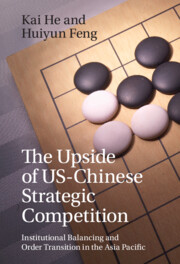 The Upside of US-Chinese Strategic Competition
The Upside of US-Chinese Strategic Competition Book contents
- The Upside of US–Chinese Strategic Competition
- The Upside of US–Chinese Strategic Competition
- Copyright page
- Dedication
- Contents
- Acknowledgments
- Abbreviations
- 1 International Order Transition and US–China Competition
- 2 Institutional Peace Theory
- 3 Institutional Balancing in the Security Suborder
- 4 Institutional Balancing in the Economic Suborder
- 5 Institutional Balancing in the Political Suborder
- 6 Building Institutional Peace in the Asia Pacific in the 21st Century
- Select Bibliography
- Index
3 - Institutional Balancing in the Security Suborder
Building a New Coexistent Security Architecture
Published online by Cambridge University Press: 25 June 2025
- The Upside of US–Chinese Strategic Competition
- The Upside of US–Chinese Strategic Competition
- Copyright page
- Dedication
- Contents
- Acknowledgments
- Abbreviations
- 1 International Order Transition and US–China Competition
- 2 Institutional Peace Theory
- 3 Institutional Balancing in the Security Suborder
- 4 Institutional Balancing in the Economic Suborder
- 5 Institutional Balancing in the Political Suborder
- 6 Building Institutional Peace in the Asia Pacific in the 21st Century
- Select Bibliography
- Index
Summary
This chapter conducts an in-depth examination of the US-China institutional competition within the security suborder in the Asia-Pacific region. It offers a comprehensive analysis of two distinct rounds of institutional balancing between the United States and China, which involve key forums like the ASEAN Regional Forum (ARF), Shangri-La Dialogue (SLD), Conference on Interaction and Confidence-Building Measures in Asia (CICA), Shanghai Cooperation Organization (SCO), Quadrilateral Security Dialogue (Quad), and ASEAN Defense Ministerial Meeting (ADMM)-Plus, spanning the post-Cold War era. Our argument suggests that this robust rivalry in institutional balancing between the United States and China has given rise to a dynamic security architecture within the Asia-Pacific region. Within this framework, bilateralism, minilateralism, and multilateralism coexist and intersect, resulting in a complex and nuanced security architecture.
Keywords
Information
- Type
- Chapter
- Information
- The Upside of US-Chinese Strategic CompetitionInstitutional Balancing and Order Transition in the Asia Pacific, pp. 58 - 89Publisher: Cambridge University PressPrint publication year: 2025